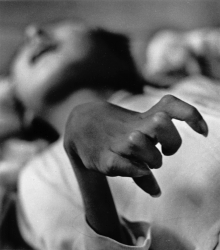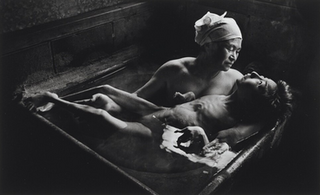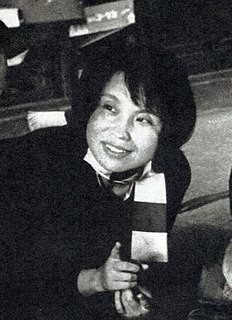Related Research Articles

Minamata disease is a neurological disease caused by severe mercury poisoning. Signs and symptoms include ataxia, numbness in the hands and feet, general muscle weakness, loss of peripheral vision, and damage to hearing and speech. In extreme cases, insanity, paralysis, coma, and death follow within weeks of the onset of symptoms. A congenital form of the disease can also affect fetuses in the womb and may cause cerebral palsy.

Minamata is a city located in Kumamoto Prefecture, Japan. It is on the west coast of Kyūshū and faces Amakusa islands. Minamata was established as a village in 1889, re-designated as a town in 1912 and grew into a city in 1949. As of March 2017, the city has an estimated population of 25,310 and a population density of 160 persons per km². The total area is 162.88 km².

William Eugene Smith was an American photojournalist. He has been described as "perhaps the single most important American photographer in the development of the editorial photo essay." His major photo essays include World War II photographs, the visual stories of an American country doctor and a nurse midwife, the clinic of Albert Schweitzer in French Equatorial Africa, the city of Pittsburgh, and the pollution which damaged the health of the residents of Minamata in Japan. His 1948 series, Country Doctor, photographed for Life, is now recognized as "the first extended editorial photo story".

The Chisso Corporation, since 2012 reorganized as JNC, is a Japanese chemical company. It is an important supplier of liquid crystal used for LCDs, but is best known for its role in the 34-year-long pollution of the water supply in Minamata, Japan that led to thousands of deaths and victims of disease.

Shisei Kuwabara is a photojournalist best known for his depiction of the effects of mercury poisoning on people in and near Minamata over a period of some forty years.
The four big pollution diseases of Japan were a group of man-made diseases all caused by environmental pollution due to improper handling of industrial wastes by Japanese corporations. The first occurred in 1912, and the other three occurred in the 1950s and 1960s.

Minamata is a small factory town. Minamata Bay is a bay on the west coast of Kyūshū island, located in Kumamoto Prefecture, Japan. The bay is part of the larger Shiranui Sea which is sandwiched between the coast of the Kyūshū mainland and the off-lying islands of Kumamoto and Nagasaki prefectures.
Hajime Hosokawa was director of the company hospital attached to the Chisso Corporation's chemical factory in Minamata, Kumamoto prefecture, Japan. He was the first doctor to discover and treat patients of the massive outbreak of mercury poisoning that occurred in the town, which became known as Minamata disease.

Tomoko and Mother in the Bath is a photograph taken by American photojournalist W. Eugene Smith in 1971. Many commentators regard Tomoko as Smith's greatest work. The black-and-white photo depicts a mother cradling her severely deformed, naked daughter in a traditional Japanese bathroom. The mother, Ryoko Kamimura, agreed to deliberately pose the startlingly intimate photograph with Smith to illustrate the terrible effects of Minamata disease on the body and mind of her daughter Tomoko Kamimura. Upon publication the photo became world-famous, significantly raising the international profile of Minamata disease and the struggle of the victims for recognition and compensation. At the wishes of Tomoko Kamimura's family, the photograph was withdrawn from further publication in 1997, 20 years after Tomoko's death.
Niigata Minamata disease is a neurological syndrome caused by severe mercury poisoning. Identical in symptoms to the original outbreak of Minamata disease in Kumamoto Prefecture, the second outbreak in Niigata Prefecture was confirmed with the same name in 1965. The disease was caused by severe mercury poisoning, the source of which was methylmercury released in the wastewater from mercury sulfate-catalysed acetaldehyde production at the Showa Electrical Company's chemical plant in Kanose village. This highly toxic compound was released untreated into the Agano River where it bioaccumulated up the food chain, contaminating fish which when eaten by local people caused symptoms including ataxia, numbness in the hands and feet, general muscle weakness, narrowing of the field of vision and damage to hearing and speech.
Ontario Minamata disease is a neurological syndrome caused by severe mercury poisoning. It occurred in the Canadian province of Ontario, in 1970, and severely affected two First Nation communities in Northwestern Ontario following consumption of local fish contaminated with mercury, and one First Nation in Southern Ontario due to illegal disposal of industrial chemical waste. The disease was named after the infamous case of severe mercury poisoning in the fishing community of Minamata, Japan, which became known as Minamata disease because it devastated only the residents of the community.
The following is a timeline of key events related to Minamata disease:
Masazumi Harada was a Japanese doctor and medical researcher. His most famous work covered the effects of Minamata disease, a type of severe mercury poisoning that occurred in the city of Minamata, Kumamoto Prefecture during the 1950s and 1960s. His publications included Minamata disease (1972) and Minamata Ga Utsusu Sekai (1989). He died June 11, 2012 of acute myelocytic leukemia at his home in Kumamoto.
The Minamata disease compensation agreements of 1959 were agreed between the polluting Chisso company and representative groups of fishermen and Minamata disease patients who had been affected by mercury pollution. The agreements and their formation shared a number of common characteristics. They were formulated outside the legal system, by ad-hoc mediation committees specially established for the purpose. Members of the committees and the final agreements were weighted in favour of Chisso and all included punitive clauses that the groups could make no future claims for compensation against the company.

Michiko Ishimure was a Japanese writer and activist.

Noriaki Tsuchimoto was a Japanese documentary film director known for his films on Minamata disease and examinations of the effects of modernization on Asia. Tsuchimoto and Shinsuke Ogawa have been called the "two figures [that] tower over the landscape of Japanese documentary."
Minamata: The Victims and Their World is a Japanese documentary made in 1971 by Noriaki Tsuchimoto. It is the first in a series of independent documentaries that Tsuchimoto made of the mercury poisoning incident in Minamata, Japan. Subsequent films in the series include The Shiranui Sea.
Timothy S. George is a Professor of History and Chair of the University of Rhode Island Department of History. He specializes in Postwar Japanese history, Citizen-corporation-state relations in Japan from Meiji through Shōwa, local history, and environmental history. A Fulbright Scholar, George's research has been reviewed in Environmental History, The Journal of Asian Studies, Social Science Japan Journal, and the Journal of Japanese Studies. He is a faculty affiliate of Harvard University's Program on U.S.-Japan Relations.

Minamata is a 2020 drama film directed by Andrew Levitas, based on the book of the same name by Aileen Mioko Smith and W. Eugene Smith. The film stars Johnny Depp as W. Eugene Smith, an American photographer who documented the effects of mercury poisoning on the citizens of Minamata, Kumamoto, Japan. The film premiered at the Berlin International Film Festival on February 21, 2020. It was released in the United States on February 11, 2022, by Samuel Goldwyn Films. At the 94th Academy Awards in 2022, the film ranked third place in the Oscars Fan Favorite contest.
References
- ↑ "Archived copy". Archived from the original on 2012-02-08. Retrieved 2010-05-17.
{{cite web}}: CS1 maint: archived copy as title (link)